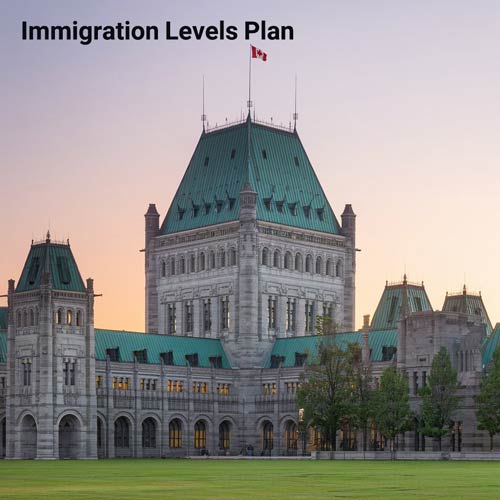Table of Contents
Canada has unveiled its Immigration Levels Plan 2025, aiming to balance economic growth and population sustainability. Focused on boosting real GDP per capita by 1.4% by 2027, the plan moderates immigration levels to alleviate housing-market strains and ease infrastructure demands, particularly in urban centers like Toronto and Vancouver. While overall economic output growth may see a slight dip, the emphasis on per capita productivity and housing affordability signals long-term benefits.
The plan retains a strong focus on skilled immigration to address labor shortages in critical sectors such as technology, healthcare, and engineering, making pathways like Express Entry and Provincial Nominee Programs (PNPs) vital for prospective immigrants. However, more competitive eligibility criteria call for careful planning and expert legal counsel.
For aspiring immigrants, firms like Sohi Law Group can provide strategic guidance, ensuring compliance and increasing success rates in navigating Canada’s evolving immigration policies. This recalibration reflects Canada’s commitment to attracting global talent while meeting domestic priorities, positioning the country for sustainable growth and enhanced living standards.
Introduction
Canada’s immigration policy continues to evolve with a strategic focus on optimizing the economic impacts of immigration. Recently, the federal government unveiled an ambitious Immigration Levels Plan, which aims to recalibrate the country’s immigration intake over the next three years. A central goal of this plan is to bolster economic growth, specifically by enhancing Canada’s real GDP per capita—a crucial measure of productivity and economic prosperity. While this recalibration is expected to yield tangible benefits for individuals within the Canadian economy, it also comes with broader implications that merit close examination.

Key Highlights of the Immigration Levels Plan 2025
The new immigration policy is positioned as a bold step to strike a balance between economic growth and sustainable population increase. One of the cornerstone objectives is to achieve a projected 1.4% rise in real GDP per capita by the year 2027. Real GDP per capita, which calculates the total economic output divided by the population, is widely regarded as a critical indicator of the standard of living and overall productivity of a nation.
As Canada shifts its focus towards lowering the pace of immigration growth, the government anticipates that this strategic move will alleviate strain on housing markets and public services while maintaining robust economic performance. This is a significant shift from previous years, where higher immigration levels were championed to address labor shortages and population aging.
Impact on Canada’s Economy
One of the primary reasons behind the slight reduction in immigration targets is the necessity to address economic pressures stemming from rapid urban population growth. As economic and labor centers like Vancouver, Toronto, and Montreal face unprecedented demands for housing and infrastructure, managing immigration flows is considered vital to ensuring resource allocation effectively meets the needs of current and future residents.
By slightly tempering immigration levels, the plan aligns with economic forecasts indicating a net positive impact on productivity. While there will be a trade-off—a modest reduction in total economic output growth by 1.7%—the strategic focus on per capita benefits reflects a clear commitment to improving long-term living standards.
This recalibration also ties into broader national goals such as stabilizing housing costs and easing cost-of-living pressures. With fewer new arrivals to meet housing demands, significant progress may be made toward improving affordability for both citizens and permanent residents alike.
Balancing Immigration and Labor Market Needs
Canada’s immigration system has long been engineered to align with labor market demands, with skilled workers being a key focus of various immigration streams. While the new plan introduces a somewhat moderated approach, it does not detract from Canada’s recognition of immigrants as integral contributors to workforce development and economic vibrancy.
Understanding the intricacies of this plan is critical for aspiring immigrants, especially skilled professionals considering relocation to Canada. The government retains its emphasis on high-skilled immigration programs to address critical labor shortages, including in industries such as technology, healthcare, and engineering. As a result, those applying through Express Entry or Provincial Nominee Programs (PNPs) will continue to find pathways accessible, albeit within a slightly revised framework.

What This Means for Prospective Immigrants
For prospective immigrants, this new strategy highlights the need for careful planning and preparation when navigating Canada’s immigration system. With the immigration flow less expansive than in prior years, eligibility criteria and selection thresholds under certain pathways may become more competitive. This underlines the importance of legal expertise in understanding program requirements and crafting compelling applications.
Legal firms such as Sohi Law Group play an instrumental role in guiding aspiring immigrants through these complexities. Whether an individual is considering Express Entry, a Provincial Nominee Program, or family reunification avenues, professional legal counsel ensures precision and compliance with immigration policies while enhancing the likelihood of success.
The Long-Term Vision
Canada’s Immigration Levels Plan 2025 is not just about managing short-term challenges—it establishes a sustainable foundation for years to come. As the country continues to prioritize economic productivity, housing affordability, and public service capacity, the moderate adjustment in immigration levels reflects thoughtful governance and adaptability to pressing national concerns.
This shift also underscores the importance of maintaining an immigration system that remains attractive to global talent while meeting critical domestic priorities. Coupled with targeted policies aimed at retaining international students and addressing sector-specific labor gaps, Canada’s approach signals its enduring commitment to being a top destination for immigrants seeking opportunities and a high standard of living.
How Sohi Law Group Can Assist
Navigating the nuances of immigration policy during a transitional phase requires meticulous preparation. The experienced team at Sohi Law Group provides tailored guidance to clients at every stage of their immigration journey. Whether it’s offering clarity on how these new regulations impact individual circumstances or assisting with application processes to ensure compliance and timeliness, Sohi Law Group is a trusted partner in helping immigrants achieve their Canadian goals.
For skilled workers, entrepreneurs, or families exploring pathways to Canada, staying informed and proactive is essential in light of these policy changes. Seeking expert legal assistance is an investment in navigating dynamic immigration systems with confidence and certainty. Sohi Law Group stands ready to help clients adapt to policy shifts while fully understanding the implications of changing immigration priorities.
Conclusion
Canada’s Immigration Levels Plan 2025 is an important recalibration to achieve a balanced economic and societal approach to immigration. With its strategic focus on boosting real GDP per capita while alleviating other economic pressures, this plan sets the stage for a prosperous future benefiting not only newcomers but also the broader Canadian population. For individuals seeking to understand how these changes might impact their aspirations for Canadian immigration, consulting with experienced legal professionals can clarify opportunities and ensure an optimal path forward in this revamped framework.





No comment